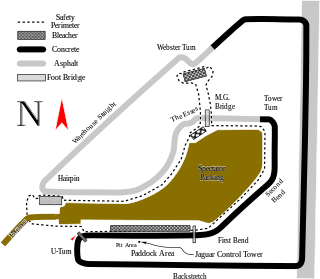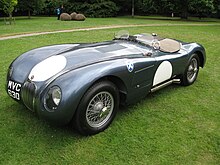
Olivier Jean Marie Fernand Gendebien was a Belgian racing driver who was called "one of the greatest sportscar racers of all time".

Ian Macpherson McCallum Stewart was a British racing driver from Scotland.
Ivor Léon John Bueb was a British professional sports car racing and Formula One driver from England.
Ron Flockhart was a British racing driver. He participated in 14 World Championship Formula One Grands Prix, achieving one podium finish and won the 24 Hours of Le Mans sportscar race twice.

Jan Ellegaard Magnussen is a Danish professional racing driver and was a factory driver for General Motors until the end of the 2020 season. He has competed in Championship Auto Racing Teams (CART), NASCAR, the FIA Formula One World Championship and the 24 Hours of Le Mans.
David Murray was a British racing driver from Scotland. He participated in five Formula One World Championship Grands Prix, debuting on 13 May 1950, and also founded the Ecurie Ecosse Scottish motor racing team, based at Merchiston Mews in Edinburgh.

David Leslie was a Scottish racing driver. He was most associated with the British Touring Car Championship, in which he was runner-up in 1999. He was particularly noted for his development skill, helping both Honda and Nissan become BTCC race winners. He was born in Dumfries, Scotland.
Ecurie Francorchamps was a Belgian motor racing team. They are principally known for running privateer cars in Formula One and sports car racing during the 1950s and 1970s. The team was founded by racing driver Jacques Swaters. Between 1952 and 1954 Ecurie Francorchamps raced in Formula One, and raced in sports cars into the 1970s.

The 1959 24 Hours of Le Mans was the 27th 24 Hours of Le Mans, Grand Prix of Endurance, and took place on 20 and 21 June 1959, on Circuit de la Sarthe. It was also the fourth round of the F.I.A. World Sports Car Championship. The prospect of an exciting duel between Ferrari, Aston Martin and giantkillers Porsche was enough to draw large crowds and some 150,000 spectators gathered for France's classic sports car race, around the 8.38-mile course.

The 1958 24 Hours of Le Mans was the 26th running of the 24 Hours of Le Mans, Grand Prix of Endurance, and took place on 21 and 22 June 1958, on the Circuit de la Sarthe. It was also the fifth round of the 1958 World Sports Car Championship, which was running to new regulations introduced at the beginning of the season. Some 150,000 spectators had gathered for Europe's classic sports car race, around the 8.38-mile course. The prospect of an exciting duel between Ferrari, Jaguar, Aston Martin and giantkiller Porsche was enough to draw large crowds to the 24 Hours race.

The 1957 24 Hours of Le Mans was the 25th running of the 24 Hours of Le Mans, Grand Prix of Endurance, and took place on 22 and 23 June 1957, on the Circuit de la Sarthe. It was also the fifth round of the F.I.A. World Sports Car Championship. Some 250,000 spectators had gathered for Europe's classic sports car race, around an 8.38-mile course. The prospect of an exciting duel between Ferrari, Maserati, Jaguar, Aston Martin and Porsche was enough to draw large crowds to the 24 Hours race, now back at its usual date and reintegrated into the World Championship.

The 1956 24 Hours of Le Mans was a race for Sports Carst which took place on 28 and 29 July 1956 on the Circuit de la Sarthe. The race was won by Ron Flockhart and Ninian Sanderson driving a Jaguar D-Type for the new Ecurie Ecosse team. This race also marked the golden jubilee of the Automobile Club de l'Ouest (ACO) founded in 1906, however because of the previous year's terrible accident, celebrations were deferred to 1957 to go along with the imminent 25th anniversary of the race.
Ninian Sanderson was a Scottish car dealer, sports car racing driver, and winner of the 1956 24 Hours of Le Mans.
Walter Ernest "Wilkie" Wilkinson (1903-2001) was a British mechanic and a founder member of the BRMC.
Ibsley Circuit was a car racing circuit situated at RAF Ibsley, on the Fordingbridge to Ringwood Road in Hampshire, United Kingdom.

The 1953 24 Heures de Spa Francorchamps took place on 25 and 26 July 1953, at the Circuit de Spa-Francorchamps, (Belgium). It was also the fourth round of the FIA World Sports Car Championship. This was the first time the event had taken place since Luigi Chinetti and Jean Lucas won in 1949. The race was not run again until 1964.

The 1956 Sveriges Grand Prix took place on 12 August, at the Råbelövsbanan, Kristianstad. Although this was the second running of the race, it was the first time as a round of the F.I.A. World Sports Car Championship. The previous year's race, won by Juan Manuel Fangio was the first big race held in Sweden, and the organiser, Kungl Automobil Klubben dealt with it so well, the F.I.A. promoted the race. For this year's event, the circuit was widened and resurfaced.

The 1957 Sveriges Grand Prix took place on 11 August, at the Rabelövsbanan, Kristianstad. Although this was the third running of the race, it was the last time as round of the F.I.A. World Sports Car Championship, and to sportscar regulations. Held on the same bumpy circuit as in 1956, the race differed this time, as it was for a period of six hours, instead of 1,000 km, it being felt that a time race would be more acceptable to the Swedish public.

The 1958 12-Hour Florida International Grand Prix of Endurance for the Amoco Trophy took place on 22 March, on the Sebring International Raceway,. It was the second round of the F.I.A. World Sports Car Championship, which was running to new regulations introduced at the beginning of the season. The most influential of these regulations changes would be the 3.0 litre engine size limit. This was seventh running of the 12-hour race.
Border Reivers was a motor racing team from Chirnside, Berwickshire in the Scottish Borders. The team was named after the raiders along the Anglo-Scottish border. Its most successful achievement was third place at the 1960 24 Hours of Le Mans. It is most notable for its involvement in the early racing career of Jim Clark, who was one of the drivers in the 1960 Le Mans entry.












